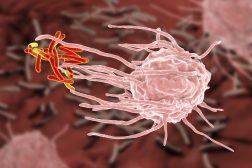Table of Contents
Definition
noun
plural: deoxyadenosine diphosphates
(biochemistry) A nucleotide composed of adenine, deoxyribose and two phosphate units, with a chemical formula: C10H15N5O9P2
Details
Overview
A nucleotide is an organic compound made up of three subunits: a nucleobase, a five-carbon sugar, and a phosphate group. The sugar component may either be ribose or deoxyribose. The ribose is the sugar component of the nucleotides that make up RNA. The deoxyribose is the sugar component of DNA. Nucleotides are the monomeric units of nucleic acids. Each phosphate group connects the sugar rings of two adjacent nucleotide monomers. The phosphate groups and the sugar moieties form the backbone of a nucleic acid. The directionality of the chain runs from 5′-end to 3′-end. In DNA, the orientation of the two strands is in opposite directions. This is to allow complementary base pairing between nucleobase constituents. A nucleotide is, thus, a nucleoside with a phosphate group. Depending on the number of phosphate groups attached to the sugar moiety. It may be called nucleoside monophosphate (if with only one phosphate group), nucleoside diphosphate (with two phosphate groups), or nucleoside triphosphate (when with three phosphate groups). Depending on the pentose sugar component, a nucleoside may be a ribonucleoside or a deoxyribonucleoside. A ribonucleoside is a nucleoside with a ribose sugar component. (Depending on the nucleobase component, the ribonucleoside may be adenosine, guanosine, cytidine, uridine, or 5-methyluridine). A deoxyribonucleoside is a nucleoside with a deoxyribose sugar. Depending on the nucleobase component, a deoxyribonucleoside may be deoxyadenosine, deoxyguanosine, deoxycytidine, thymidine, or deoxyuridine. Also, depending on the nucleobase component, the nucleosides may be grouped into either the “double-ringed” purine or the “single-ringed” pyrimidine.
Deoxyadenosine diphosphate is a purine nucleotide composed of adenine, deoxyribose and two phosphate units, with a chemical formula: C10H15N5O9P2
Characteristics
Deoxyadenosine diphosphate (dADP) is a nucleoside phosphate in being comprised of a deoxyribonucleoside and two phosphate units. This means that it has a deoxyribose as its sugar constituent with two phosphate units attached. Its nucleoside contains a purine base, i.e. an adenine attached to the deoxyribose sugar.
dADP vs ADP
Adenosine diphosphate (ADP) is a nucleotide composed of adenine, ribose and two phosphate units. It has a chemical formula of C10H15N5O10P2. It differs from dADP in terms of the sugar component. dADP, instead of having a hydroxyl group on the 2′ carbon on the on pentose sugar as it is in ADP, has it reduced to a hydrogen atom (thus, deoxy- in its name).
Biological functions
dADP is a metabolite. It has a role in purine metabolism. It is present in the mitochondria and the nucleus of certain cells. In humans, it is found in various tissues such as cartilage, epidermis, fibroblasts, neurons, platelets, skeletal muscle, and spleen. 1
Supplementary
Abbreviation(s)
- dADP
- deoxy-ADP
IUPAC
Chemical formula
- C10H15N5O9P2
Further reading
See also
- nucleotide
- DNA
- adenosine
- adenosine monophosphate (AMP)
- deoxyadenosine monophosphate (dAMP)
- deoxyadenosine triphosphate (dATP)
Reference
- Human Metabolome Database: Showing metabocard for dADP (HMDB0001508). (2019). Retrieved from Hmdb.ca website: ://www.hmdb.ca/metabolites/HMDB0001508 Link
© Biology Online. Content provided and moderated by Biology Online Editors







